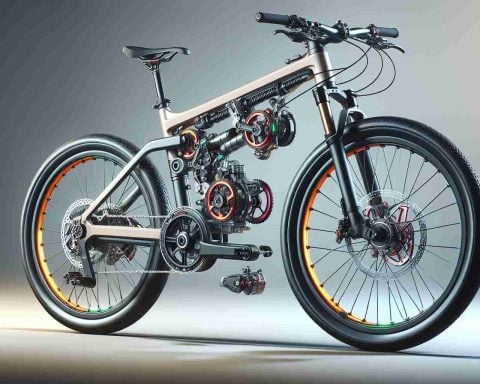DJI, popularly known as the king of drones, is now making its mark in a completely different industry – electric mobility. The Chinese drone giant is venturing into e-bikes with its Avinox Drive System and the Amflow electric mountain bike, marking a significant expansion of the company’s product categories.
DJI’s entry into the e-bike space is notable not only because it is a departure from their usual offerings but also because of their comprehensive approach. The company aims to control the entire process of bicycle manufacturing, including drives, frames, and technology.
The Avinox Drive System showcased by DJI is an impressive first step into the e-bike market. The Amflow bike, weighing only 42 lbs, boasts a peak power of 850W, thanks to DJI’s mid-drive Avinox system. This power-to-weight ratio ensures excellent performance on trails while maintaining easy maneuverability. Moreover, the Avinox system delivers an impressive 105 lb-ft of torque, setting a new standard for first-ever e-bikes.
In terms of battery performance, DJI offers two options for the Avinox Drive System – a 600Wh battery and an 800Wh battery. The 800Wh battery, in particular, stands out as it can be charged from 0 to 75 percent in just 1.5 hours using GaN charging technology. This feature is particularly beneficial for riders who may forget to charge their bikes in advance.
One of the most intriguing aspects of the Avinox system is its technology suite. Leveraging their expertise in drones, DJI incorporates sensors into the Avinox system to implement a “Smart-Assist Algorithm.” This algorithm utilizes multiple sensors on the bike to automatically adjust assistance based on riding resistance, providing a seamless and intuitive riding experience comparable to driver assist features in cars.
Riders can choose from four different assist modes – auto, eco, trail, and turbo – allowing them to customize their riding experience. Additionally, DJI offers a “boost” mode for extra power. To enhance the user experience further, DJI provides the Avinox companion app, enabling riders to customize ride assist levels and other parameters.
Notably, the Avinox system features a two-inch OLED touchscreen that serves as an interface and readout, exemplifying the premium quality of DJI’s tech-focused bike.
While specific details about the Amflow, such as price and release date, are still unknown, DJI’s maiden entry into the e-bike market shows promise. If DJI’s success in the drone industry is any indication, other e-bike manufacturers should take notice as the competition in the electric mobility space heats up.
In conclusion, DJI’s push into electric mobility with the Avinox Drive System and the Amflow e-bike demonstrates the company’s commitment to diversifying its product offerings. With their technological prowess and comprehensive approach, DJI has the potential to make a significant impact in the e-bike market, much like they did in the drone industry.
The e-bike industry is experiencing significant growth and is projected to continue expanding in the coming years. One report suggests that the global e-bike market size will exceed $40 billion by 2025, driven by increasing environmental concerns, the need for alternative transportation options, and advancements in battery technology.
This forecast bodes well for DJI’s entry into the e-bike market. As a renowned player in the drone industry, DJI brings its technological expertise and reputation for innovation to the electric mobility space. With their Avinox Drive System and the upcoming Amflow e-bike, DJI aims to capture a share of this rapidly growing market.
However, there are several challenges and issues related to the e-bike industry that DJI must navigate. One hurdle is the regulation and legislation surrounding e-bikes, which can vary significantly across different countries and regions. E-bikes are often subject to specific speed limits, licensing requirements, and usage restrictions. DJI will need to ensure that their e-bikes comply with the relevant regulations in order to enter new markets successfully.
Another issue faced by the e-bike industry is concerns about safety and security. As e-bikes become more popular, there is a growing need for improved infrastructure, such as dedicated bike lanes and charging stations. Additionally, measures to prevent theft and protect riders’ personal data are critical in ensuring the long-term viability and trustworthiness of e-bikes.
DJI’s foray into the e-bike market also raises questions about the potential impact on the traditional bicycle industry. As e-bikes gain popularity, there may be a shift in demand from traditional bicycles to electric variants. This could disrupt the existing supply chains and business models of bike manufacturers, leading to both challenges and opportunities for industry players.
For more information on the e-bike industry, market forecasts, and related issues, you can visit reputable industry websites such as ebikes.ca and electricbikereport.com. These sources provide comprehensive insights into the e-bike market and offer valuable analysis and data for those interested in the industry’s future prospects.























